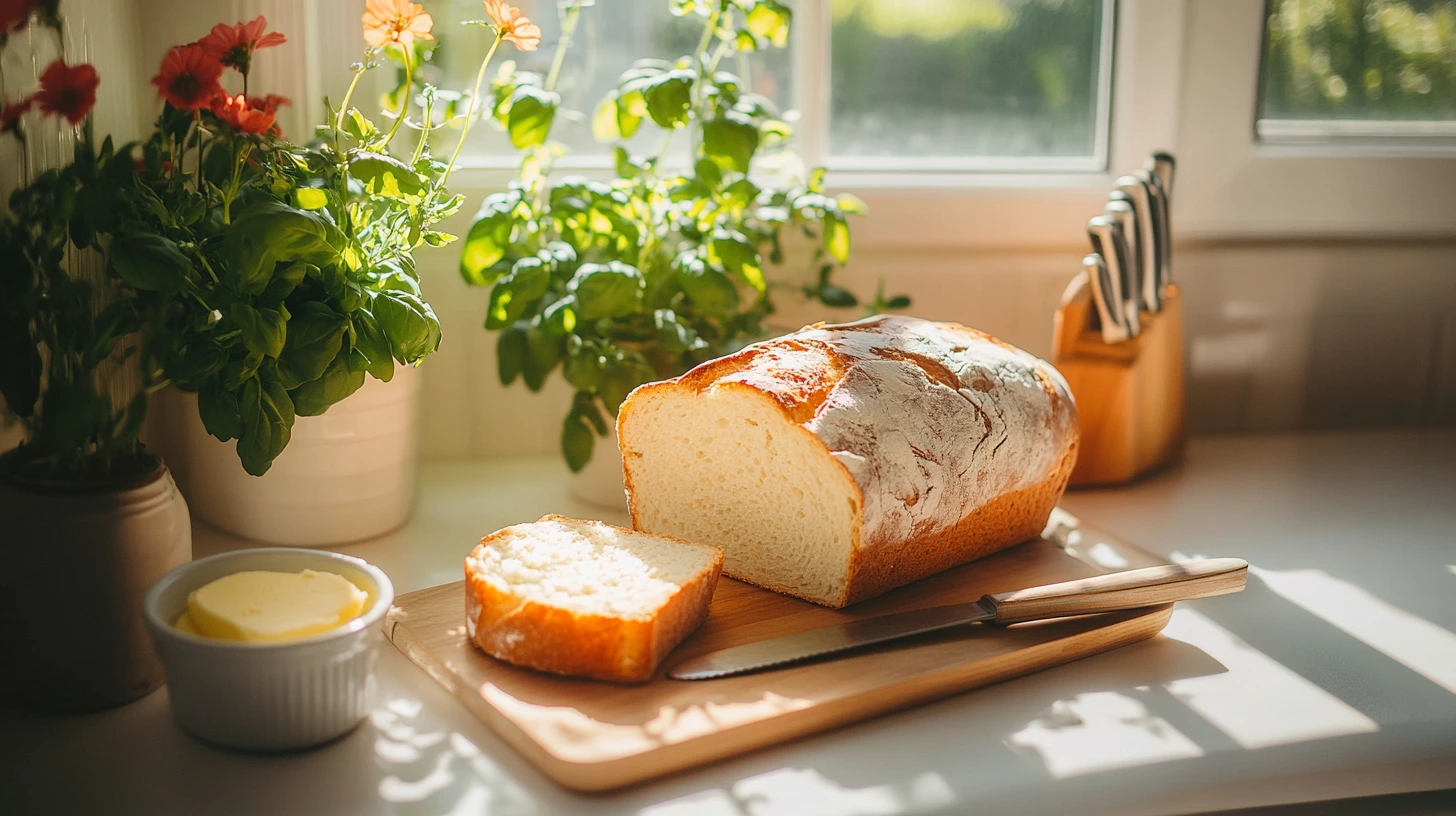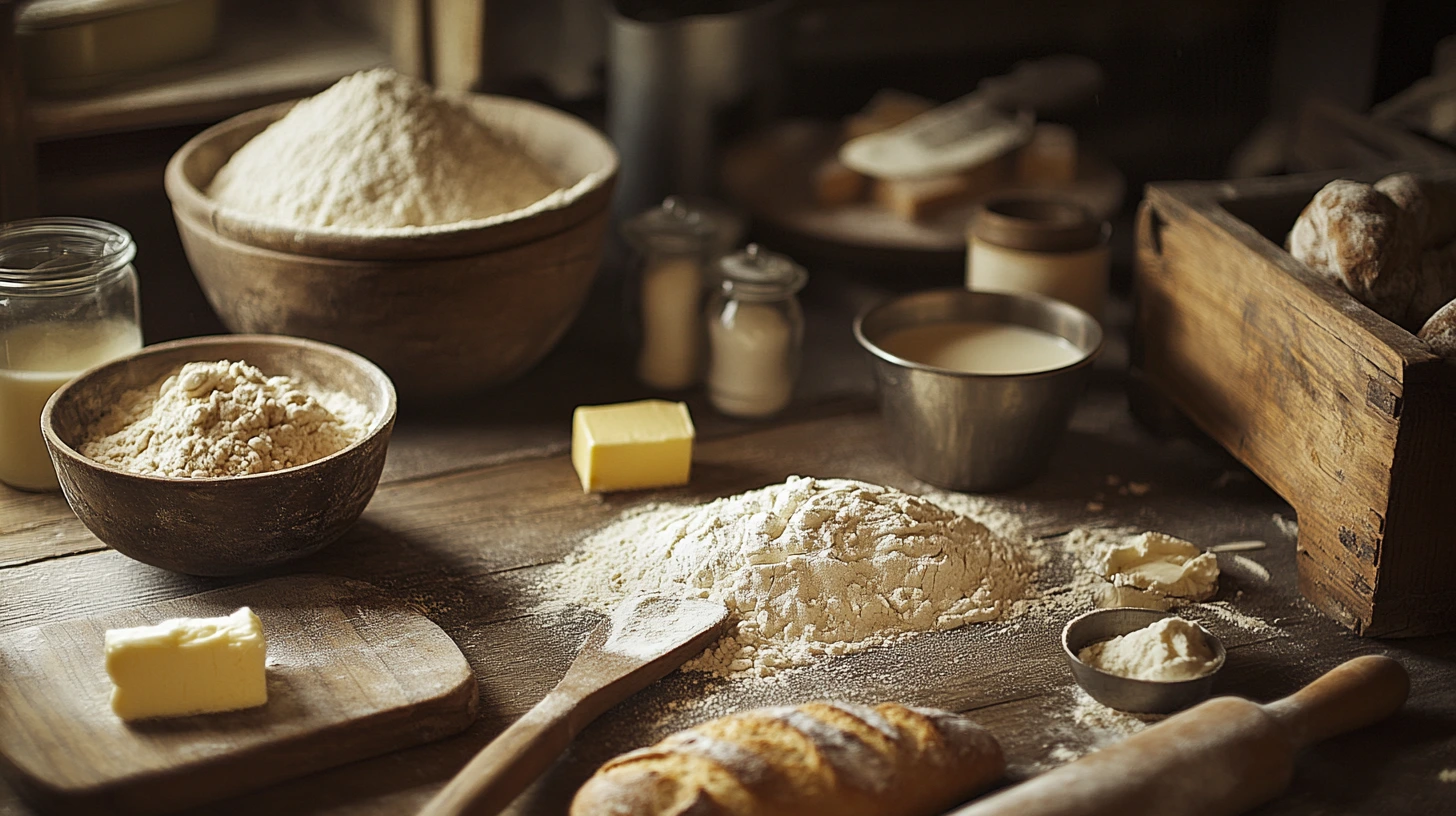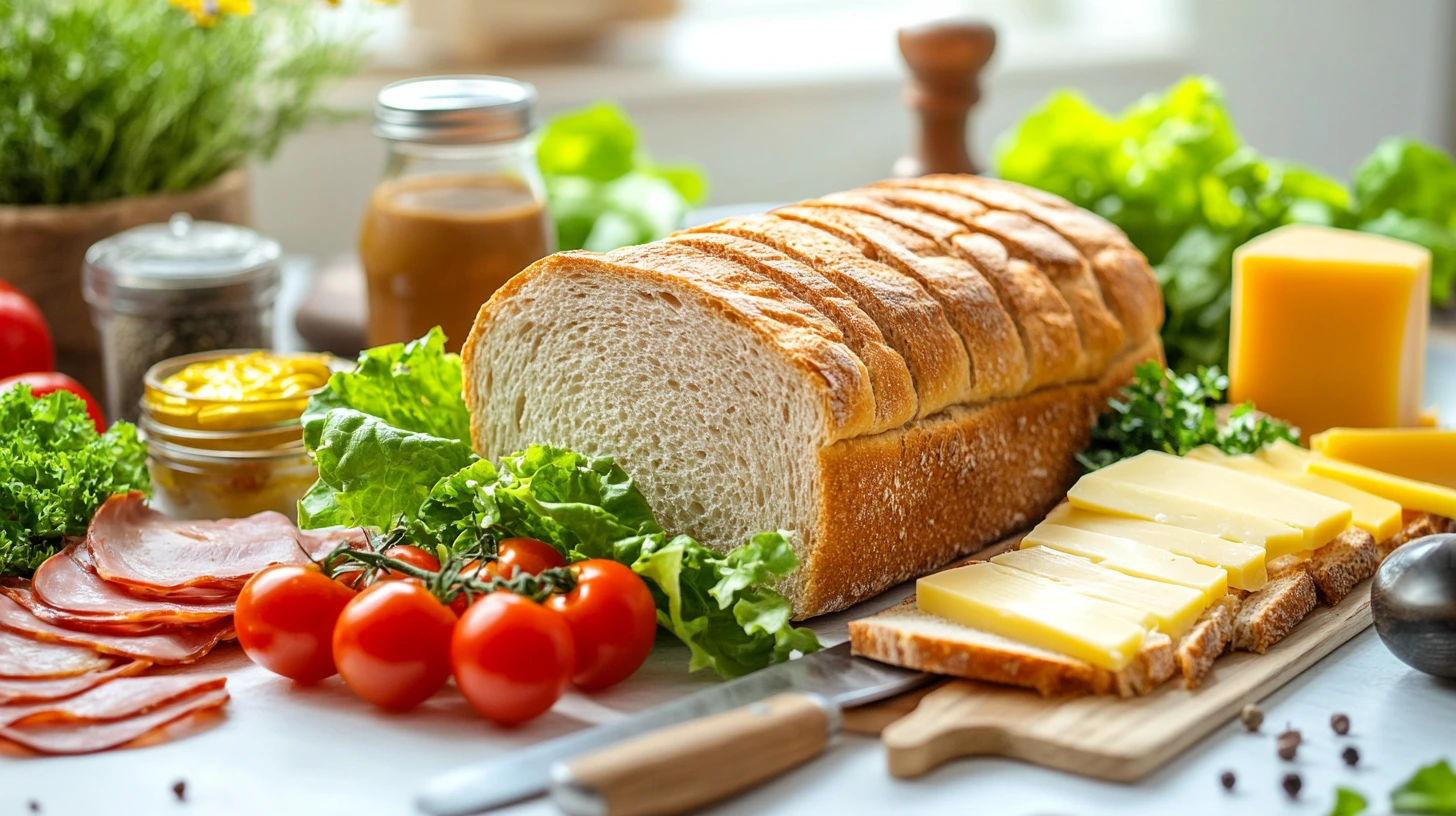
Table of Contents
Introduction to Sandwich Bread
Sandwich bread recipe is a kitchen staple, providing the perfect base for everything from simple peanut butter and jelly to gourmet deli creations. While grabbing a loaf at the store is easy, nothing compares to the flavor, texture, and satisfaction of making your sandwich bread at home.
Homemade sandwich bread is soft, fluffy, and versatile, ideal for various meals and snacks. Whether toasted for breakfast, layered with fresh ingredients for lunch, or used for decadent desserts like bread pudding, this bread elevates every dish it accompanies.
Making sandwich bread at home also allows you to control the ingredients, ensuring a fresher, healthier, and more natural product. It’s a chance to skip the preservatives and additives in store-bought options while adding your touch with whole grains, seeds, or even a hint of sweetness.
Ingredients for Sandwich Bread Recipe

Basic Ingredients:
- Flour:
- All-Purpose Flour: Suitable for a soft and fluffy loaf.
- Bread flour: Contains higher protein, which results in better gluten development and a chewier texture.
- Yeast:
- Active Dry Yeast: Requires activation in warm Water before use.
- Instant Yeast: Can be mixed directly with dry ingredients for convenience.
- Liquid:
- Water: Warm Water is essential for activating Yeast and hydrating the dough.
- Milk (optional): This adds richness and a softer crumb. Whole milk is preferred, but plant-based alternatives work, too.
- Sweetener:
- Sugar, honey, or maple syrup provides a slight sweetness and feeds the Yeast to help it rise.
- Fat:
- Butter, oil, or shortening improves the bread’s softness and extends shelf life.
- Salt:
- It is essential for flavor and helps regulate yeast activity.
Optional Additions for Enhanced Flavor and Nutrition:
- Whole Grains: For added fiber, substitute part of the flour with whole wheat, rye, or spelled flour.
- Seeds and Nuts: For texture and nutrients, add flaxseeds, sesame seeds, sunflower seeds, or chopped nuts.
- Dairy Enhancements: Add powdered milk for a tender crumb.
- Eggs: Include eggs for a more decadent dough and slightly denser loaf.
- Herbs and Spices: Mix dried herbs, garlic powder, or onion flakes for a savory twist.
Example Quantities for a Classic Loaf:
- 3 cups (375g) bread flour or all-purpose flour.
- One packet (2 ¼ tsp) of active dry or instant yeast.
- 1 cup (240ml) warm Water or milk.
- Two tablespoons (30g) sugar or honey.
- Two tablespoons (30g) unsalted butter or vegetable oil.
- One teaspoon salt.
Core Ingredients: Flour, Yeast, and Water
- Flour:
- All-Purpose Flour: A versatile choice that creates a soft, tender loaf.
- Bread flour: Contains higher protein, leading to more muscular gluten development and a chewier texture, which is ideal for sandwich bread.
- Whole Wheat Flour: For a more nutritious loaf, substitute part of the all-purpose or bread flour with whole wheat flour.
- Yeast:
- Active Dry Yeast: This must be dissolved in warm Water before being mixed with other ingredients.
- Instant Yeast: This can be mixed directly with dry ingredients for convenience and quicker rising times.
- Water:
- Warm Water (105°F–110°F) activates the Yeast and hydrates the dough. However, it should not be too hot, as it could kill the Yeast.
- Milk (Optional): Substituting Water with milk (or using a mix of both) adds richness and produces a softer crust.
Optional Additions for Flavor and Texture
- Sweeteners:
- Sugar, Honey, or Maple Syrup adds a subtle sweetness and feeds the Yeast, aiding the rising process.
- Fat:
- Butter, Oil, or Shortening: Enhances the bread’s softness, richness, and shelf life.
- Eggs:
- Adds richness and moisture, resulting in a slightly denser and more flavorful loaf.
- Whole Grains and Seeds:
- Incorporate rolled oats, flaxseeds, sunflower, or chia seeds for added texture and nutritional value.
- Herbs and Spices:
- Add dried herbs (like rosemary or thyme), garlic powder, or onion flakes for a savory twist.
- Nuts and Dried Fruits:
- Chopped nuts or dried fruits like raisins or cranberries can transform your sandwich bread into a sweeter, more complex loaf.
- Dairy Enhancements:
- Powdered Milk or Yogurt: Adds a subtle tang and tenderizes the crumb.
Types of Flour and Their Impact

All-Purpose vs. Bread Flour
- All-Purpose Flour:
- Protein Content: 10-12%, suitable for a soft and tender loaf.
- Texture: It produces less chewy bread with a finer crumb, making it ideal for lighter sandwich bread.
- Best For: Beginner-friendly recipes and those who prefer a softer texture.
- Bread Flour:
- Protein Content: 12-14%, higher than all-purpose flour.
- Texture: Creates stronger gluten, resulting in a chewy, structured loaf with a more elastic dough.
- Best for: Recipes requiring a sturdy loaf, such as sandwich bread, that hold up well to spreads and fillings.
Tip: You can substitute all-purpose flour for bread flour, but the bread might rise lower or have a different chewy texture. Adding a tablespoon of vital wheat gluten per cup of all-purpose flour can mimic bread flour’s effects.
Whole Wheat and Gluten-Free Alternatives
- Whole Wheat Flour:
- Nutritional Value: Fiber, vitamins, and minerals are higher than refined flours.
- Texture: Denser and heavier due to the bran and germ content, which can inhibit gluten development.
- Best Practices:
- Substitute up to 50% of the white flour with whole wheat flour for a balanced texture.
- Add extra liquid or a tablespoon of vital wheat gluten to improve elasticity and softness.
- Flavor: Earthy and nutty, ideal for more wholesome loaves.
- Gluten-Free Flour:
- Composition: Typically made from a blend of rice flour, tapioca starch, potato starch, and xanthan gum for binding.
- Texture: Gluten-free bread can be more crumbly without gluten, but proper techniques and recipes ensure a soft loaf.
- Best Practices:
- Use gluten-free bread flour blends designed explicitly for yeast-based recipes.
- Add eggs, psyllium husk, or flaxseed gel for structure and moisture.
- Flavor: Mild and adaptable, allowing the other ingredients to shine.
Step-by-Step Sandwich Bread Recipe Instructions
Mixing the Dough
- Ingredients:
- 3 cups (375g) bread flour or all-purpose flour.
- 1 cup (240ml) warm water or milk (105°F–110°F).
- One packet (2 ¼ tsp) active dry or instant Yeast.
- Two tablespoons (30g) sugar or honey.
- Two tablespoons (30g) butter or oil, melted.
- One teaspoon salt.
- Instructions:
- Activate Yeast (for active dry Yeast): Dissolve the Yeast in warm Water or milk with a pinch of sugar. Let it sit for 5-10 minutes until frothy. For instant Yeast, skip this step and mix it directly with the dry ingredients.
- Combine the flour, sugar, and salt in a large mixing bowl.
- Add the yeast mixture (or combine the instant Yeast), warm liquid, and melted butter/oil to the dry ingredients.
- Stir with a wooden spoon or use a stand mixer with a dough hook attachment until a rough dough forms.
Kneading Techniques Sandwich Bread Recipe
- Hand Kneading:
- Transfer the dough to a lightly floured surface.
- Push the dough away with the heel of your hand, fold it back, and rotate. Repeat for 8-10 minutes until the dough is smooth, elastic, and slightly tacky but not sticky.
- Stand Mixer Kneading:
- Use the dough hook attachment and knead quickly for 6-8 minutes. The dough should clean the sides of the bowl but stick slightly to the bottom.
Tip: Test for readiness by performing the “windowpane test.” Stretch a small piece of dough between your fingers; if it forms a thin, translucent layer without tearing, it’s kneaded enough.
First and Second Rises
- First Rise:
- Shape the dough into a ball and place it in a lightly greased bowl. Cover with a clean kitchen towel or plastic wrap.
- Let the dough rise in a warm, draft-free spot for 1-2 hours or until it doubles in size.
- Punching Down:
- Gently punch down the risen dough to release excess air.
- Shaping and Second Rise:
- Depending on your recipe, shape the dough into a loaf or rolls. Please place it in a greased loaf pan or onto a baking sheet.
- Cover and let it rise again for 30-45 minutes, or until it has doubled in size and springs back lightly when pressed with a fingertip.
Baking Techniques for Sandwich Bread Recipe
How to Achieve a Golden Crust
- Preheat the Oven:
- Set your oven to 375°F (190°C) for a standard sandwich bread loaf. A properly preheated oven ensures even baking and a golden crust.
- Use an Egg Wash:
- Mix one egg with one tablespoon of Water or milk and brush it lightly over the surface of the dough before baking. This creates a shiny, golden crust.
- Substitute the egg wash with milk or melted butter for a softer crust.
- Steam for a Crisper Crust:
- Place a pan of hot Water on the bottom rack of the oven while the bread bakes. The steam helps create a slightly crisp and evenly browned crust.
- Alternatively, mist the dough lightly with Water just before baking.
- Baking Times:
- A standard loaf typically bakes in 30-35 minutes. Monitor the bread closely in the last 5 minutes to avoid over-browning.
Testing for Doneness
- Visual Cues:
- The crust should be golden brown and slightly firm to the touch.
- Tap Test:
- Remove the bread from the oven and tap the bottom of the loaf. A hollow sound indicates the bread is fully baked.
- Internal Temperature:
- Use an instant-read thermometer inserted into the center of the loaf. The bread is done when the internal temperature reaches 190°F–200°F (88°C–93°C).
- Cooling:
- Allow the bread to cool in the pan for 10-15 minutes, then transfer it to a wire rack to cool completely. Cutting into hot bread can release steam, affecting the texture of the crumb.
Tips for Soft, Fluffy Bread
Controlling Moisture and Texture
- Hydration Level:
- Use the right amount of liquid to achieve a soft dough. The dough should be slightly tacky but not sticky. Too little liquid can produce dry bread, while too much can make it dense.
- Fat Content:
- Incorporate fats like butter, oil, or milk to tenderize the dough and create a soft crumb. Substitute part of the Water with whole milk or add an egg to the dough for extra richness.
- Kneading:
- Proper kneading ensures gluten development, which traps air and creates a fluffy texture. Knead until the dough is smooth and elastic.
- Humidity During Baking:
- Add steam to the oven by placing a pan of hot Water on the bottom rack or misting the dough lightly with Water before baking. This helps the bread stay moist and soft.
- Cooling:
- Let the bread cool completely on a wire rack to prevent condensation from making the crust soggy.
Avoiding Common Mistakes
- Overworking or Underworking the Dough:
- The under-kneaded dough needs to develop more gluten, resulting in dense bread. Over-kneading (especially in a stand mixer) can make the dough too tight, leading to a tough texture.
- Too Much Flour:
- Adding too much flour can stiffen the dough, resulting in dry, dense bread. Stick to the recipe’s measurements and add flour gradually if needed.
- Improper Yeast Handling:
- Use fresh Yeast and activate it at the correct temperature (105°F–110°F). Water that’s too hot will kill the Yeast, while Water that’s too cool will slow its activity.
- Skipping Rises:
- Allowing the dough to rise correctly ensures it has the time to develop air pockets for a soft and fluffy texture. Rushing this step can lead to dense bread.
- Over proofing or Underproofing:
- Overproofed dough may collapse during baking, while underproofed dough won’t rise enough. Check for readiness by lightly pressing the dough—if it springs back slowly, it’s ready to bake.
- Baking at the Wrong Temperature:
- Too low temperature can result in underbaked bread with a gummy interior, while too high can burn the crust before the center is fully cooked.
Storing and Freezing Sandwich Bread Recipe
Keeping Bread Fresh
- Room Temperature Storage:
- Wrap the bread tightly in plastic wrap or store it in a resealable plastic bag.
- Keep it at room temperature for up to 3-4 days. Avoid storing bread in the refrigerator, as it accelerates staling.
- Use a Bread Box:
- A bread box maintains the proper humidity level, preventing the bread from drying out while keeping the crust from becoming too soft.
- Refresh Stale Bread:
- If the bread begins to stale, wrap it in foil and warm it in the oven at 300°F (150°C) for 10-15 minutes to restore some freshness.
How to Freeze for Long-Term Storage
- Preparing for Freezing:
- Allow the bread to cool completely after baking. Freezing warm bread can lead to condensation and freezer burn.
- Slice the bread before freezing to make it easier to thaw, and use individual portions.
- Packaging:
- Wrap the loaf or slices tightly in plastic wrap, ensuring no part is exposed to air.
- Place the wrapped bread in a resealable freezer bag or airtight container for protection.
- Freezer Life:
- Bread can be stored in the freezer for up to 3 months. After this period, it may begin to lose flavor and texture.
- Thawing and Reheating:
- Thaw at room temperature by removing the bread from its packaging to prevent condensation.
- To refresh frozen bread, warm it in the oven at 300°F (150°C) for 10-15 minutes or toast individual slices directly from frozen.
Sandwich Ideas Using Homemade Bread

Classic Sandwiches
- Grilled Cheese Sandwich:
- Ingredients: Slices of homemade bread, butter, and your favorite cheese (cheddar, Swiss, or mozzarella).
- Preparation: Butter one side of each bread slice, place cheese between the unbuttered sides, and grill in a pan until the bread is golden brown and the cheese is melted.
- Tip: Add tomato slices or caramelized onions for a flavorful twist.
- Egg Salad Sandwich:
- Ingredients: Hard-boiled eggs, mayonnaise, Dijon mustard, salt, and pepper.
- Preparation: Mix the eggs with mayo, mustard, and seasonings. Spread the egg salad on bread and top with lettuce if desired.
- Tip: Add chopped chives or paprika for extra flavor.
Variations of Sandwich Bread Recipe
Whole Wheat Sandwich Bread
Whole wheat sandwich bread is a nutritious alternative to traditional white bread, offering a hearty texture and rich flavor.
- Ingredients:
- Replace 50-100% of the all-purpose or bread flour with whole wheat flour.
- Add 1-2 tablespoons of honey or molasses to balance the earthy flavor of whole wheat.
- Increase the liquid slightly, as whole wheat flour absorbs more moisture than white flour.
- Tips for a Softer Loaf:
- Mix whole wheat flour with bread flour to balance softness and structure.
- Use milk or a combination of milk and Water for a more decadent crumb.
- Incorporate a tablespoon of vital wheat gluten to improve elasticity and rise.
- Flavor Additions:
- Add rolled oats, flaxseeds, or sunflower seeds for extra texture and nutrition.
Gluten-Free and Vegan Options
Gluten-free, vegan sandwich bread caters to dietary restrictions without sacrificing flavor or texture.
Bread Gluten-Free:
- Ingredients:
- For binding, use a gluten-free all-purpose flour blend with xanthan gum or psyllium husk.
- Add eggs or flaxseed gel (1 tablespoon flaxseed meal + 3 tablespoons water) for moisture and structure.
- Substitute dairy milk with plant-based milk like almond, soy, or oat.
- Tips for Success:
- Gluten-free dough is usually wetter than traditional dough—don’t overcompensate with flour.
- Use a stand mixer to ensure even mixing and aeration.
- Allow the dough to rise only once, as gluten-free bread doesn’t require a second proofing.
Vegan Bread:
- Ingredients:
- Replace butter with plant-based alternatives like coconut, olive, or vegan margarine.
- Use plant-based milk or Water as the liquid component.
- For sweetness, opt for maple syrup, agave nectar, or sugar.
- Tips for Enriched Texture:
- Add mashed potatoes or applesauce for a tender, moist crumb.
- Brush the loaf with almond milk before baking for a golden crust.
Frequently Asked Questions (FAQs)
Can I Make Sandwich Bread Recipe Without a Mixer?
Yes, you can make sandwich bread entirely by hand! Here’s how:
- Mixing by Hand:
- Combine the ingredients in a large mixing bowl using a wooden spoon until the dough becomes a rough ball.
- Kneading by Hand:
- Transfer the dough to a lightly floured surface. Knead by pushing the dough with the heel of your hand, folding it back, and turning it slightly.
- Continue kneading for 8-10 minutes until the dough is smooth, elastic, and slightly tacky but not sticky.
- Tips for Hand Kneading:
- If the dough sticks to your hands, lightly dust them with flour, but avoid adding too much to keep it soft.
- Test the dough’s readiness with the “windowpane test.” Stretch a small piece of dough between your fingers—if it forms a thin, translucent layer without tearing, it’s ready.
How Do I Know the Bread is Fully Risen?
Proper rising is key to soft, airy sandwich bread. Here’s how to check:
- First Rise (Bulk Fermentation):
- The dough should double in size. This usually takes 1-2 hours in a warm, draft-free area.
- Test by pressing your finger gently into the dough. If the indentation remains, the dough is ready.
- Second Rise (Proofing):
- After shaping the dough into a loaf and placing it in the pan, allow it to rise again until it has doubled in size and the dough is just above the rim.
- Test by gently pressing your finger into the dough. The bread is fully proofed and ready to bake if it springs back slowly.
Common Issues with Rising:
- Too Slow: If the dough isn’t rising, check the room temperature—it should be around 75°F–80°F. Place the dough near a warm spot, like on top of a preheating oven or in a microwave with a cup of warm Water.
- Overproofing: Overrisen dough may collapse during baking. Keep an eye on it and avoid letting it rise for too long.
Conclusion
Homemade sandwich bread is more than just a recipe—it’s a fulfilling experience that combines simple ingredients with care and creativity to produce a versatile and delicious staple. From the aroma of freshly baked bread filling your kitchen to the satisfaction of slicing into a perfectly risen loaf, the process is as rewarding as the result.
By understanding key techniques like mixing, kneading, and proofing and exploring variations such as whole wheat or gluten-free options, you can tailor your bread to suit your taste and dietary preferences. Sandwich bread’s adaptability makes it perfect for a variety of meals, from classic sandwiches to gourmet creations.
Try this recipe tonight and tag us @biscsweet on social media and follow us on Facebook.
